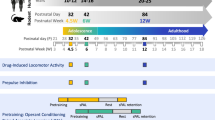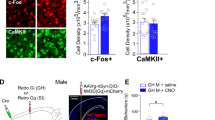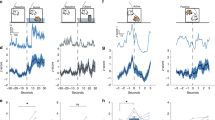Abstract
During adolescence, the prefrontal cortex (PFC) undergoes dramatic reorganization. PFC development is profoundly influenced by the social environment, disruptions to which may prime the emergence of psychopathology across the lifespan. We investigated the neurobehavioral consequences of isolation experienced in adolescence in mice, and in particular, the long-term consequences that were detectable even despite normalization of the social milieu. Isolation produced biases toward habit-like behavior at the expense of flexible goal seeking, plus anhedonic-like reward deficits. Behavioral phenomena were accompanied by neuronal dendritic spine over-abundance and hyper-excitability in the ventromedial PFC (vmPFC), which was necessary for the expression of isolation-induced habits and sufficient to trigger behavioral inflexibility in socially reared controls. Isolation activated cytoskeletal regulatory pathways otherwise suppressed during adolescence, such that repression of constituent elements prevented long-term isolation-induced neurosequelae. Altogether, our findings unveil an adolescent critical period and multi-model mechanism by which social experiences facilitate prefrontal cortical maturation.
This is a preview of subscription content, access via your institution
Access options
Subscribe to this journal
Receive 12 print issues and online access
$259.00 per year
only $21.58 per issue
Buy this article
- Purchase on Springer Link
- Instant access to full article PDF
Prices may be subject to local taxes which are calculated during checkout





Similar content being viewed by others
Data availability
Individual data points are reported throughout. Data may be available from the corresponding author upon reasonable request.
References
Baumeister RF, Leary MR. The need to belong: desire for interpersonal attachments as a fundamental human motivation. Psychol Bull. 1995;117:497–529.
Leigh-Hunt N, Bagguley D, Bash K, Turner V, Turnbull S, Valtorta N, et al. An overview of systematic reviews on the public health consequences of social isolation and loneliness. Public Health. 2017;152:157–71. https://doi.org/10.1016/j.puhe.2017.07.035.
Matthews GA, Tye KM. Neural mechanisms of social homeostasis. Ann N. Y Acad Sci. 2019;1457:5–25. https://doi.org/10.1111/nyas.14016.
Li DC, Hinton EA, Gourley SL. Persistent behavioral and neurobiological consequences of social isolation during adolescence. Semin Cell Dev Biol. 2021;118:73–82. https://doi.org/10.1016/j.semcdb.2021.05.017.
Spear LP. The adolescent brain and age-related behavioral manifestations. Neurosci Biobehav Rev. 2000;24:417–63. https://doi.org/10.1016/s0149-7634(00)00014-2.
Andrews JL, Ahmed SP, Blakemore SJ. Navigating the social environment in adolescence: the role of social brain development. Biol Psychiatry. 2021;89:109–18. https://doi.org/10.1016/j.biopsych.2020.09.012.
Gopnik A, O’Grady S, Lucas CG, Griffiths TL, Wente A, Bridgers S, et al. Changes in cognitive flexibility and hypothesis search across human life history from childhood to adolescence to adulthood. Proc Natl Acad Sci USA. 2017;114:7892–9. https://doi.org/10.1073/pnas.1700811114.
Burke AR, McCormick CM, Pellis SM, Lukkes JL. Impact of adolescent social experiences on behavior and neural circuits implicated in mental illnesses. Neurosci Biobehav Rev. 2017;76:280–300. https://doi.org/10.1016/j.neubiorev.2017.01.018.
Mills KL, Goddings AL, Clasen LS, Giedd JN, Blakemore SJ. The developmental mismatch in structural brain maturation during adolescence. Dev Neurosci. 2014;36:147–60. https://doi.org/10.1159/000362328.
Paus T. Mapping brain maturation and cognitive development during adolescence. Trends Cogn Sci. 2005;9:60–8. https://doi.org/10.1016/j.tics.2004.12.008.
Gogtay N, Giedd JN, Lusk L, Hayashi KM, Greenstein D, Vaituzis AC, et al. Dynamic mapping of human cortical development during childhood through early adulthood. Proc Natl Acad Sci USA. 2004;101:8174–9. https://doi.org/10.1073/pnas.0402680101.
Bourgeois JP, Goldman-Rakic PS, Rakic P. Synaptogenesis in the prefrontal cortex of rhesus monkeys. Cereb Cortex. 1994;4:78–96. https://doi.org/10.1093/cercor/4.1.78.
Huttenlocher PR, Dabholkar AS. Regional differences in synaptogenesis in human cerebral cortex. J Comp Neurol. 1997;387:167–78. 10.1002/(sici)1096-9861(19971020)387:2<167::aid-cne1>3.0.co;2-z
Boivin JR, Piekarski DJ, Thomas AW, Wilbrecht L. Adolescent pruning and stabilization of dendritic spines on cortical layer 5 pyramidal neurons do not depend on gonadal hormones. Dev Cogn Neurosci. 2018;30:100–7. https://doi.org/10.1016/j.dcn.2018.01.007.
Rakic P, Bourgeois JP, Goldman-Rakic PS. Synaptic development of the cerebral cortex: implications for learning, memory, and mental illness. Prog Brain Res. 1994;102:227–43. https://doi.org/10.1016/S0079-6123(08)60543-9.
Paus T, Zijdenbos A, Worsley K, Collins DL, Blumenthal J, Giedd JN, et al. Structural maturation of neural pathways in children and adolescents: in vivo study. Science. 1999;283:1908–11. https://doi.org/10.1126/science.283.5409.1908.
Keshavan MS, Giedd J, Lau JY, Lewis DA, Paus T. Changes in the adolescent brain and the pathophysiology of psychotic disorders. Lancet Psychiatry. 2014;1:549–58. https://doi.org/10.1016/S2215-0366(14)00081-9.
Crews F, He J, Hodge C. Adolescent cortical development: a critical period of vulnerability for addiction. Pharm Biochem Behav. 2007;86:189–99. https://doi.org/10.1016/j.pbb.2006.12.001.
Dalsgaard S, Thorsteinsson E, Trabjerg BB, Schullehner J, Plana-Ripoll O, Brikell I, et al. Incidence rates and cumulative incidences of the full spectrum of diagnosed mental disorders in childhood and adolescence. JAMA Psychiatry. 2020;77:155–64. https://doi.org/10.1001/jamapsychiatry.2019.3523.
Kessler RC, Berglund P, Demler O, Jin R, Merikangas KR, Walters EE. Lifetime prevalence and age-of-onset distributions of DSM-IV disorders in the National Comorbidity Survey Replication. Arch Gen Psychiatry. 2005;62:593–602. https://doi.org/10.1001/archpsyc.62.6.593.
Orben A, Tomova L, Blakemore SJ. The effects of social deprivation on adolescent development and mental health. Lancet Child Adolesc Health. 2020;4:634–40. https://doi.org/10.1016/S2352-4642(20)30186-3.
Thapar A, Collishaw S, Pine DS, Thapar AK. Depression in adolescence. Lancet. 2012;379:1056–67. https://doi.org/10.1016/S0140-6736(11)60871-4.
Patterson TK, Craske MG, Knowlton BJ. The effect of early-life stress on memory systems supporting instrumental behavior. Hippocampus. 2013;23:1025–34. https://doi.org/10.1002/hipo.22174.
Dickinson A. Actions and habits: the development of behavioural autonomy. Philos Trans R Soc B. 1985;308:67–78.
Lawlor VM, Webb CA, Wiecki TV, Frank MJ, Trivedi M, Pizzagalli DA, et al. Dissecting the impact of depression on decision-making. Psychol Med, 1–10, https://doi.org/10.1017/S0033291719001570 (2019).
Swanson AM, Shapiro LP, Whyte AJ, Gourley SL. Glucocorticoid receptor regulation of action selection and prefrontal cortical dendritic spines. Commun Integr Biol. 2013;6:e26068 https://doi.org/10.4161/cib.26068.
Olafsson RP, Guethmundsdottir SJ, Bjornsdottir TD, Snorrason I. A test of the habit-goal framework of depressive rumination and its relevance to cognitive reactivity. Behav Ther. 2020;51:474–87. https://doi.org/10.1016/j.beth.2019.08.005.
Watkins ER, Nolen-Hoeksema S. A habit-goal framework of depressive rumination. J Abnorm Psychol. 2014;123:24–34. https://doi.org/10.1037/a0035540.
Killcross S, Coutureau E. Coordination of actions and habits in the medial prefrontal cortex of rats. Cereb Cortex. 2003;13:400–8. https://doi.org/10.1093/cercor/13.4.400.
Coutureau E, Killcross S. Inactivation of the infralimbic prefrontal cortex reinstates goal-directed responding in overtrained rats. Behav Brain Res. 2003;146:167–74. https://doi.org/10.1016/j.bbr.2003.09.025.
Smith KS, Graybiel AM. A dual operator view of habitual behavior reflecting cortical and striatal dynamics. Neuron. 2013;79:361–74. https://doi.org/10.1016/j.neuron.2013.05.038.
Smith KS, Virkud A, Deisseroth K, Graybiel AM. Reversible online control of habitual behavior by optogenetic perturbation of medial prefrontal cortex. Proc Natl Acad Sci USA. 2012;109:18932–7. https://doi.org/10.1073/pnas.1216264109.
Hitchcott PK, Quinn JJ, Taylor JR. Bidirectional modulation of goal-directed actions by prefrontal cortical dopamine. Cereb Cortex. 2007;17:2820–7. https://doi.org/10.1093/cercor/bhm010.
Barker JM, Glen WB, Linsenbardt DN, Lapish CC, Chandler LJ. Habitual behavior is mediated by a shift in response-outcome encoding by Infralimbic Cortex. eNeuro (2017) 4, https://doi.org/10.1523/ENEURO.0337-17.2017.
Gass JT, Chandler LJ. The plasticity of extinction: contribution of the prefrontal cortex in treating addiction through inhibitory learning. Front Psychiatry. 2013;4:46 https://doi.org/10.3389/fpsyt.2013.00046.
Heilbronner SR, Rodriguez-Romaguera J, Quirk GJ, Groenewegen HJ, Haber SN. Circuit-based corticostriatal homologies between rat and primate. Biol Psychiatry. 2016;80:509–21. https://doi.org/10.1016/j.biopsych.2016.05.012.
Mayberg HS, Liotti M, Brannan SK, McGinnis S, Mahurin RK, Jerabek PA, et al. Reciprocal limbic-cortical function and negative mood: converging PET findings in depression and normal sadness. Am J Psychiatry. 1999;156:675–82. https://doi.org/10.1176/ajp.156.5.675.
Mayberg HS, Lozano AM, Voon V, McNeely HE, Seminowicz D, Hamani C, et al. Deep brain stimulation for treatment-resistant depression. Neuron. 2005;45:651–60. https://doi.org/10.1016/j.neuron.2005.02.014.
Crowell AL, Garlow SJ, Riva-Posse P, Mayberg HS. Characterizing the therapeutic response to deep brain stimulation for treatment-resistant depression: a single center long-term perspective. Front Integr Neurosci. 2015;9:41 https://doi.org/10.3389/fnint.2015.00041.
Dandekar MP, Fenoy AJ, Carvalho AF, Soares JC, Quevedo J. Deep brain stimulation for treatment-resistant depression: an integrative review of preclinical and clinical findings and translational implications. Mol Psychiatry. 2018;23:1094–112. https://doi.org/10.1038/mp.2018.2.
Berry KP, Nedivi E. Spine dynamics: are they all the same? Neuron. 2017;96:43–55. https://doi.org/10.1016/j.neuron.2017.08.008.
DeNardo LA, Berns DS, DeLoach K, Luo L. Connectivity of mouse somatosensory and prefrontal cortex examined with trans-synaptic tracing. Nat Neurosci. 2015;18:1687–97. https://doi.org/10.1038/nn.4131.
Li DC, Dighe NM, Barbee BR, Pitts EG, Kochoian B, Blumenthal SA, et al. A molecularly integrated amygdalo-fronto-striatal network coordinates flexible learning and memory. Nat Neurosci. 2022;25:1213–24.
Zimmermann KS, Li CC, Rainnie DG, Ressler KJ, Gourley SL. Memory retention involves the ventrolateral orbitofrontal cortex: comparison with the basolateral Amygdala. Neuropsychopharmacology. 2018;43:373–83. https://doi.org/10.1038/npp.2017.139.
Kataoka N, Shima Y, Nakajima K, Nakamura K. A central master driver of psychosocial stress responses in the rat. Science. 2020;367:1105–12. https://doi.org/10.1126/science.aaz4639.
Schwabe L, Hermans EJ, Joels M, Roozendaal B. Mechanisms of memory under stress. Neuron, https://doi.org/10.1016/j.neuron.2022.02.020 (2022).
Subramanian A, Tamayo P, Mootha VK, Mukherjee S, Ebert BL, Gillette MA, et al. Gene set enrichment analysis: a knowledge-based approach for interpreting genome-wide expression profiles. Proc Natl Acad Sci USA. 2005;102:15545–50. https://doi.org/10.1073/pnas.0506580102.
Greathouse KM, Boros BD, Deslauriers JF, Henderson BW, Curtis KA, Gentry EG, et al. Distinct and complementary functions of rho kinase isoforms ROCK1 and ROCK2 in prefrontal cortex structural plasticity. Brain Struct Funct. 2018;223:4227–41. https://doi.org/10.1007/s00429-018-1748-4.
Newell-Litwa KA, Badoual M, Asmussen H, Patel H, Whitmore L, Horwitz AR. ROCK1 and 2 differentially regulate actomyosin organization to drive cell and synaptic polarity. J Cell Biol. 2015;210:225–42. https://doi.org/10.1083/jcb.201504046.
Trapp S, O’Doherty JP, Schwabe L. Stressful events as teaching signals for the brain. Trends Cogn Sci. 2018;22:475–8. https://doi.org/10.1016/j.tics.2018.03.007.
Vogel S, Schwabe L. Tell me what to do: Stress facilitates stimulus-response learning by instruction. Neurobiol Learn Mem. 2018;151:43–52. https://doi.org/10.1016/j.nlm.2018.03.022.
Packard MG, Gadberry T, Goodman J. Neural systems and the emotion-memory link. Neurobiol Learn Mem. 2021;185:107503 https://doi.org/10.1016/j.nlm.2021.107503.
DePoy LM, Shapiro LP, Kietzman HW, Roman KM, Gourley SL. beta1-Integrins in the developing orbitofrontal cortex are necessary for expectancy updating in mice. J Neurosci. 2019;39:6644–55. https://doi.org/10.1523/JNEUROSCI.3072-18.2019.
Butkovich LM, DePoy LM, Allen AG, Shapiro LP, Swanson AM, Gourley SL. Adolescent-onset GABAA alpha1 silencing regulates reward-related decision making. Eur J Neurosci. 2015;42:2114–21. https://doi.org/10.1111/ejn.12995.
Moin Afshar N, Keip AJ, Taylor JR, Lee D, Groman SM. Reinforcement learning during adolescence in rats. J Neurosci. (2020), https://doi.org/10.1523/JNEUROSCI.0910-20.2020.
Naneix F, Marchand AR, Di Scala G, Pape JR, Coutureau E. Parallel maturation of goal-directed behavior and dopaminergic systems during adolescence. J Neurosci. 2012;32:16223–32. https://doi.org/10.1523/JNEUROSCI.3080-12.2012.
Hinton, EA, Li, DC, Allen, AG & Gourley, SL. Social isolation in adolescence disrupts cortical development and goal-dependent decision-making in adulthood, despite social reintegration. eNeuro 6, https://doi.org/10.1523/ENEURO.0318-19.2019 (2019).
Barfield ET, Gerber KJ, Zimmermann KS, Ressler KJ, Parsons RG, Gourley SL. Regulation of actions and habits by ventral hippocampal trkB and adolescent corticosteroid exposure. PLoS Biol. 2017;15:e2003000 https://doi.org/10.1371/journal.pbio.2003000.
Wu C, Zheng W, Jia X, Li Y, Shen F, Haghparast A, et al. Adolescent chronic unpredictable stress causes a bias in goal-directed behavior and distinctively changes the expression of NMDA and dopamine receptors in the dorsomedial and dorsolateral striatum in male rats. Dev Psychobiol. 2022;64:e22235 https://doi.org/10.1002/dev.22235.
Gordon AL, Patterson TK, Knowlton BJ. Early-life stress is associated with a preponderance of habitual responding in a novel instrumental avoidance learning paradigm. Neurobiol Learn Mem. 2020;175:107316 https://doi.org/10.1016/j.nlm.2020.107316.
Tottenham N. The importance of early experiences for neuro-affective development. Curr Top Behav Neurosci. 2014;16:109–29. https://doi.org/10.1007/7854_2013_254.
Callaghan BL, Richardson R. Early experiences and the development of emotional learning systems in rats. Biol Mood Anxiety Disord. 2013;3:8 https://doi.org/10.1186/2045-5380-3-8.
McEwen BS, Morrison JH. The brain on stress: vulnerability and plasticity of the prefrontal cortex over the life course. Neuron. 2013;79:16–29. https://doi.org/10.1016/j.neuron.2013.06.028.
Sequeira MK, Gourley SL. The stressed orbitofrontal cortex. Behav Neurosci. 2021;135:202–9. https://doi.org/10.1037/bne0000456.
Shapiro LP, Parsons RG, Koleske AJ, Gourley SL. Differential expression of cytoskeletal regulatory factors in the adolescent prefrontal cortex: Implications for cortical development. J Neurosci Res. 2017;95:1123–43. https://doi.org/10.1002/jnr.23960.
Delevich K, Okada NJ, Rahane A, Zhang Z, Hall CD, Wilbrecht L. Sex and pubertal status influence dendritic spine density on frontal corticostriatal projection neurons in mice. Cereb Cortex. 2020;30:3543–57. https://doi.org/10.1093/cercor/bhz325.
Bell HC, Pellis SM, Kolb B. Juvenile peer play experience and the development of the orbitofrontal and medial prefrontal cortices. Behav Brain Res. 2010;207:7–13. https://doi.org/10.1016/j.bbr.2009.09.029.
Bicks LK, Yamamuro K, Flanigan ME, Kim JM, Kato D, Lucas EK, et al. Prefrontal parvalbumin interneurons require juvenile social experience to establish adult social behavior. Nat Commun. 2020;11:1003 https://doi.org/10.1038/s41467-020-14740-z.
Yamamuro K, Bicks LK, Leventhal MB, Kato D, Im S, Flanigan ME, et al. A prefrontal-paraventricular thalamus circuit requires juvenile social experience to regulate adult sociability in mice. Nat Neurosci. 2020;23:1240–52. https://doi.org/10.1038/s41593-020-0695-6.
Yamamuro K, Yoshino H, Ogawa Y, Makinodan M, Toritsuka M, Yamashita M, et al. Social isolation during the critical period reduces synaptic and intrinsic excitability of a subtype of pyramidal cell in mouse prefrontal cortex. Cereb Cortex. 2018;28:998–1010. https://doi.org/10.1093/cercor/bhx010.
Park G, Ryu C, Kim S, Jeong SJ, Koo JW, Lee YS, et al. Social isolation impairs the prefrontal-nucleus accumbens circuit subserving social recognition in mice. Cell Rep. 2021;35:109104 https://doi.org/10.1016/j.celrep.2021.109104.
Armbruster-Genc DJN, Valton V, Neil L, Vuong V, Freeman ZCL, Packer KC, et al. Altered reward and effort processing in children with maltreatment experience: a potential indicator of mental health vulnerability. Neuropsychopharmacology. 2022;47:1063–70. https://doi.org/10.1038/s41386-022-01284-7.
Stringaris A, Vidal-Ribas Belil P, Artiges E, Lemaitre H, Gollier-Briant F, Wolke S, et al. The brain’s response to reward anticipation and depression in adolescence: dimensionality, specificity, and longitudinal predictions in a community-based sample. Am J Psychiatry. 2015;172:1215–23. https://doi.org/10.1176/appi.ajp.2015.14101298.
Ferenczi EA, Zalocusky KA, Liston C, Grosenick L, Warden MR, Amatya D, et al. Prefrontal cortical regulation of brainwide circuit dynamics and reward-related behavior. Science. 2016;351:aac9698 https://doi.org/10.1126/science.aac9698.
Alexander L, Gaskin PLR, Sawiak SJ, Fryer TD, Hong YT, Cockcroft GJ, et al. Fractionating blunted reward processing characteristic of anhedonia by over-activating primate subgenual anterior cingulate cortex. Neuron. 2019;101:307–20 e306. https://doi.org/10.1016/j.neuron.2018.11.021.
Morris LS, Costi S, Tan A, Stern ER, Charney DS, Murrough JW. Ketamine normalizes subgenual cingulate cortex hyper-activity in depression. Neuropsychopharmacology. 2020;45:975–81. https://doi.org/10.1038/s41386-019-0591-5.
Lander SS, Linder-Shacham D, Gaisler-Salomon I. Differential effects of social isolation in adolescent and adult mice on behavior and cortical gene expression. Behav Brain Res. 2017;316:245–54. https://doi.org/10.1016/j.bbr.2016.09.005.
Kietzman HW, Shapiro LP, Trinoskey-Rice G, Gourley SL. Cell adhesion presence during adolescence controls the architecture of projection-defined prefrontal cortical neurons and reward-related action strategies later in life. Dev Cogn Neurosci. 2022;54:101097 https://doi.org/10.1016/j.dcn.2022.101097.
Shapiro LP, Kietzman HW, Guo J, Rainnie DG, Gourley SL. Rho-kinase inhibition has antidepressant-like efficacy and expedites dendritic spine pruning in adolescent mice. Neurobiol Dis. 2019;124:520–30. https://doi.org/10.1016/j.nbd.2018.12.015.
Garcia-Rojo G, Fresno C, Vilches N, Diaz-Veliz G, Mora S, Aguayo F, et al. The ROCK inhibitor fasudil prevents chronic restraint stress-induced depressive-like behaviors and dendritic spine loss in rat hippocampus. Int J Neuropsychopharmacol. 2017;20:336–45. https://doi.org/10.1093/ijnp/pyw108.
Swanger SA, Mattheyses AL, Gentry EG, Herskowitz JH. ROCK1 and ROCK2 inhibition alters dendritic spine morphology in hippocampal neurons. Cell Logist. 2015;5:e1133266 https://doi.org/10.1080/21592799.2015.1133266.
Kang MG, Guo Y, Huganir RL. AMPA receptor and GEF-H1/Lfc complex regulates dendritic spine development through RhoA signaling cascade. Proc Natl Acad Sci USA. 2009;106:3549–54. https://doi.org/10.1073/pnas.0812861106.
Xing L, Yao X, Williams KR, Bassell GJ. Negative regulation of RhoA translation and signaling by hnRNP-Q1 affects cellular morphogenesis. Mol Biol Cell. 2012;23:1500–9. https://doi.org/10.1091/mbc.E11-10-0867.
Inan SY, Soner BC, Sahin AS. Infralimbic cortex Rho-kinase inhibition causes antidepressant-like activity in rats. Prog Neuropsychopharmacol Biol Psychiatry. 2015;57:36–43. https://doi.org/10.1016/j.pnpbp.2014.10.008.
Fox ME, Chandra R, Menken MS, Larkin EJ, Nam H, Engeln M, et al. Dendritic remodeling of D1 neurons by RhoA/Rho-kinase mediates depression-like behavior. Mol Psychiatry. 2020;25:1022–34. https://doi.org/10.1038/s41380-018-0211-5.
Zimmermann KS, Yamin JA, Rainnie DG, Ressler KJ, Gourley SL. Connections of the mouse orbitofrontal cortex and regulation of goal-directed action selection by brain-derived neurotrophic factor. Biol Psychiatry. 2017;81:366–77. https://doi.org/10.1016/j.biopsych.2015.10.026.
Kim IH, Kim N, Kim S, Toda K, Catavero CM, Courtland JL, et al. Dysregulation of the synaptic cytoskeleton in the PFC drives neural circuit pathology, leading to social dysfunction. Cell Rep. 2020;32:107965 https://doi.org/10.1016/j.celrep.2020.107965.
Moda-Sava, RN, Murdock, MH, Parekh, PK, Fetcho, RN, Huang, BS, Huynh, TN, et al. Sustained rescue of prefrontal circuit dysfunction by antidepressant-induced spine formation. Science 364, https://doi.org/10.1126/science.aat8078 (2019).
Feng G, Mellor RH, Bernstein M, Keller-Peck C, Nguyen QT, Wallace M, et al. Imaging neuronal subsets in transgenic mice expressing multiple spectral variants of GFP. Neuron. 2000;28:41–51. https://doi.org/10.1016/s0896-6273(00)00084-2.
Simon NG. The genetics of intermale aggressive behavior in mice: recent research and alternative strategies. Neurosci Biobehav Rev. 1979;3:97–106.
Yang M, Abrams DN, Zhang JY, Weber MD, Katz AM, Clarke AM, et al. Low sociability in BTBR T+tf/J mice is independent of partner strain. Physiol Behav. 2012;107:649–62. https://doi.org/10.1016/j.physbeh.2011.12.025.
Radley JJ, Anderson RM, Hamilton BA, Alcock JA, Romig-Martin SA. Chronic stress-induced alterations of dendritic spine subtypes predict functional decrements in an hypothalamo-pituitary-adrenal-inhibitory prefrontal circuit. J Neurosci. 2013;33:14379–91. https://doi.org/10.1523/JNEUROSCI.0287-13.2013.
Jasnow AM, Ehrlich DE, Choi DC, Dabrowska J, Bowers ME, McCullough KM, et al. Thy1-expressing neurons in the basolateral amygdala may mediate fear inhibition. J Neurosci. 2013;33:10396–404. https://doi.org/10.1523/JNEUROSCI.5539-12.2013.
Ehrlich DE, Ryan SJ, Hazra R, Guo JD, Rainnie DG. Postnatal maturation of GABAergic transmission in the rat basolateral amygdala. J Neurophysiol. 2013;110:926–41. https://doi.org/10.1152/jn.01105.2012.
Guo JD, O’Flaherty BM, Rainnie DG. Serotonin gating of cortical and thalamic glutamate inputs onto principal neurons of the basolateral amygdala. Neuropharmacology. 2017;126:224–32. https://doi.org/10.1016/j.neuropharm.2017.09.013.
Herskowitz JH, Feng Y, Mattheyses AL, Hales CM, Higginbotham LA, Duong DM, et al. Pharmacologic inhibition of ROCK2 suppresses amyloid-beta production in an Alzheimer’s disease mouse model. J Neurosci. 2013;33:19086–98. https://doi.org/10.1523/JNEUROSCI.2508-13.2013.
Gourley SL, Olevska A, Warren MS, Taylor JR, Koleske AJ. Arg kinase regulates prefrontal dendritic spine refinement and cocaine-induced plasticity. J Neurosci. 2012;32:2314–23. https://doi.org/10.1523/JNEUROSCI.2730-11.2012.
Acknowledgements
This work was supported by NIH grants F30MH117873 (DCL), R01MH117103 (SLG), and P50MH100023 (SLG). The Emory National Primate Research Center is supported by the Office of Research Infrastructure Programs grant P30OD011132. The Emory Viral Vector Core is supported by NINDS Core Facilities grant P30NS055077. The Emory Integrated Genomics Core is a shared resource of Winship Cancer Institute of Emory University and NIH/NCI under grant P30CA138292. Additional research support was provided by The Marcus Foundation, Children’s Healthcare of Atlanta, and Emory University’s Pediatrics Integrated Cellular Imaging Core.
Author information
Authors and Affiliations
Contributions
Conceptualization: DCL, EAH, SLG. Methodology: DCL, EAH, JDG, SLG. Investigation: DCL, EAH, JDG, KAK, MKS, MEW, NMD. Formal Analysis: JDG, MEW, DCL. Writing: DCL, SLG. Supervision: SLG.
Corresponding authors
Ethics declarations
Competing interests
The authors declare no competing interests.
Additional information
Publisher’s note Springer Nature remains neutral with regard to jurisdictional claims in published maps and institutional affiliations.
Supplementary information
Rights and permissions
Springer Nature or its licensor (e.g. a society or other partner) holds exclusive rights to this article under a publishing agreement with the author(s) or other rightsholder(s); author self-archiving of the accepted manuscript version of this article is solely governed by the terms of such publishing agreement and applicable law.
About this article
Cite this article
Li, D.C., Hinton, E.A., Guo, J. et al. Social experience in adolescence shapes prefrontal cortex structure and function in adulthood. Mol Psychiatry (2024). https://doi.org/10.1038/s41380-024-02540-6
Received:
Revised:
Accepted:
Published:
DOI: https://doi.org/10.1038/s41380-024-02540-6



